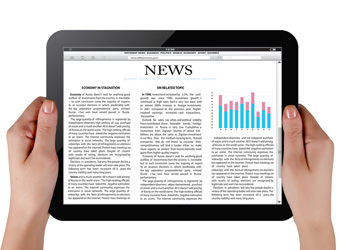Some Known Factual Statements About Popular News
Table of ContentsThe Basic Principles Of Popular News Things about Popular NewsPopular News Can Be Fun For EveryoneThe smart Trick of Popular News That Nobody is Talking About
Age is likewise a variable in the method people see the duty of social media sites. More youthful social networks news customers are much more likely to say it has influenced their discovering right. Concerning fifty percent of social networks news customers ages 18 to 29 (48%) say information on social media sites makes them much better educated, compared to 37% of those 30 to 49, 28% of those 50 to 64, and 27% of those 65 and older.Reporters evaluate information values when identifying whether or not to cover an event or news. Probably the most important component of newsworthiness is whether or not the information product being communicated effects an information electrical outlet's audience.
Closeness is crucial. Journalists have an interest in points that impact their neighborhoods. For instance, research study on a state's brand-new tax obligation code most likely won't produce the same interest across state boundaries. Occasionally professionals can aid localize a bigger nationwide story that affects more than simply a city or state. In these instances, it is essential to be in search of opportunities where subject matter experts can give understanding or where similar tasks may be occurring locally.
If you are publishing newsworthy research study, loophole in MarComm before the article being published to make sure that the pitch can stress the newest element of the tale: the magazine of the study. Events and announcements that entail high-profile figures are more probable to create media coverage. Brows through from national figures typically call for months of prep work as a result of anticipated community interest.
The Main Principles Of Popular News
We can help alleviate potential reputational danger with these tales while also raising the chances of creating coverage. While several of the above information values are intertwined, human interest stories commonly stand apart.
Human rate of interest elements can add information value to other tales that could appear to be doing not have in the other values. The uniqueness or peculiarity of a situation can aid affect whether or not a news electrical outlet is likely to cover a tale. While this is not an extensive list, inspecting to see if your information product or occasion has these top qualities prior to contacting us will assist you establish which elements hold the most information value.

Popular News - An Overview
There is likewise substantial proof that more consumers can begin to pay for information in the futureif authors can comprehend them and serve them well. Fifty percent of those who do not spend for news actively seek out information and look like subscribers in numerous methods. And almost 2 in 10 of those who do not subscribe to information currently indicate they are inclined to start to pay in the future.
We then ask a collection of concerns to figure out whether individuals pay for particular kinds of news resources (Popular browse around this site News). We asked people to name the resources they use most oftenwhether they spend for them or nothow they use them, the details things they take into consideration crucial regarding them, and some relevant questions concerning the expense and value of that source
Individuals are drawn to news in general for 2 reasons above others: A wish to be notified citizens (newspaper clients specifically are extremely inspired by this) and because the magazine they sign up for excels at covering certain topics about which those customers particularly care. While there are a host of reasons, the No.
Even more than 4 in 10 additionally cite the reality that loved ones register for the same item (Popular News). More than a 3rd of people state they originally subscribed in response to a price cut or promotion. In print, individuals likewise are moved greatly to subscribe to get discount coupons that save them find more information cash, something that has untapped implications in digital
All About Popular News
About half are "news applicants," meaning they actively look for news as opposed to mainly running into it in a more passive method, though the information that nonpayers are seeking (for now, at least) is frequently regarding nationwide politics. Like clients, a lot of these people also get news several times a day, utilize the news in methods similar to customers, and want comparable topics, including foreign or worldwide news.

Of those that do pay, 54 percent sign up for papers in print or digitally, which stands for 29 percent of Americans generally. A lot of them acquire a print publication together with their newspaper and pay for two to 4 news resources in overall, some much more. And while 53 percent are veteran subscribers (5+ years), informative post even more than a quarter (27 percent) have acquired their paper registration within the past year.
Couple of print subscribers assume it most likely they will certainly change to a digital-only registration in the future, and majority of those who like digital have never ever paid for a print variation of the very same source. Totally 75 percent of newspaper payers state they primarily reviewed the paper in print, while 21 percent are mainly electronic users, and 4 percent explain themselves as equally divided.